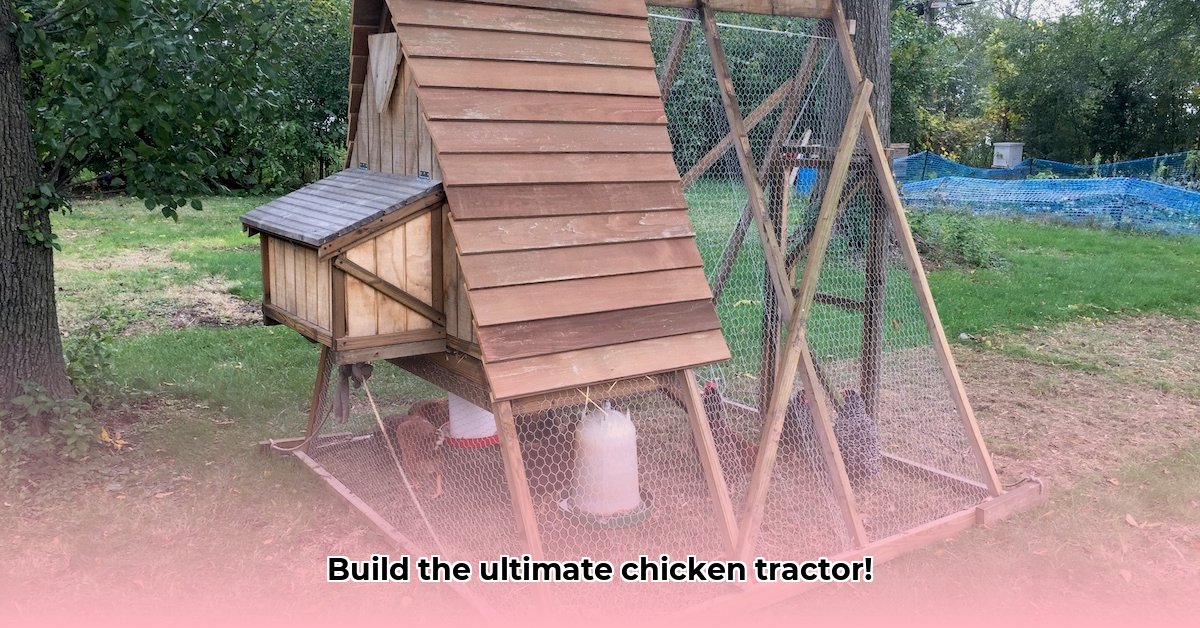
Building your own A-frame chicken tractor offers a rewarding blend of sustainable agriculture and practical poultry keeping. This guide provides a step-by-step approach to building a durable, mobile coop that protects your flock and promotes healthy pasture management. Whether you're a seasoned homesteader or a beginner, this guide will equip you with the knowledge and confidence to create a thriving chicken paradise. For larger coop designs, see larger tractor plans.
Planning Your A-Frame Chicken Tractor: Laying the Foundation
Before diving into construction, careful planning ensures a successful project. Consider these key factors:
Flock Size: Determine the number of chickens you'll house. This directly impacts the dimensions of your coop. Overcrowding stresses chickens and increases disease risk. A general rule of thumb is 4 square feet per bird.
Pasture Size: Assess your available yard space. This will influence the size and mobility of the tractor. Rotational grazing with a mobile coop enhances pasture health.
Materials Sourcing: Explore cost-effective and sustainable options. Reclaimed or responsibly sourced lumber is a great eco-friendly choice. Investigate local lumber yards and recycling centers for potential savings.
Local Regulations: Check local ordinances regarding chicken keeping before you begin. This includes zoning regulations, coop size restrictions, and potential permits.
Gathering Your Supplies: The Essential Checklist
The quantities listed below are estimates; adjust them based on your chosen design and flock size. Prioritize durable, weather-resistant materials for longevity and reduced maintenance.
| Material | Quantity (Estimate) | Notes |
|---|---|---|
| Treated Lumber (2x4s) | Eight 8-foot lengths (minimum) | Pressure-treated lumber resists rot and decay. |
| Plywood (½ inch) | Two sheets (minimum) | For the sides and roof; choose exterior-grade plywood for weather resistance. |
| Hardware Cloth (1/2" mesh minimum) | Sufficient for sides and bottom | Prevents predator access while allowing ventilation. |
| Hinges and Latches | As needed | Robust hinges and secure latches are crucial for chicken safety. |
| Nails and Screws | Plenty | Galvanized fasteners enhance durability and weather resistance. |
| Roofing Material | Sufficient for roof coverage | Consider asphalt shingles, metal sheeting, or heavy-duty tarp; waterproof is key. |
| Paint or Wood Sealer | As needed | Environmentally friendly options are preferred for a sustainable approach. |
| Wheels or Runners | Four | Ensure they're rated for the weight of the loaded coop. |
Building Your Chicken Tractor: A Step-by-Step Construction Guide
Building your A-frame is achievable even for beginners. Remember safety precautions: wear safety glasses and gloves; ensure proper ventilation while working with paints and sealers.
Constructing the A-Frames: Build two identical A-frames using your lumber. Numerous online plans provide detailed diagrams and instructions. Sturdy construction is paramount for stability and longevity.
Attaching the Sides: Secure the plywood to the A-frames, creating the coop walls. Leave openings for ventilation and a door. Attach the hardware cloth externally for predator protection. Ensure the hardware cloth is securely fastened to prevent escapes or intrusions.
Building the Roof: Construct a gable roof, ensuring it's watertight. Your chosen roofing material significantly impacts the coop’s weather resistance.
Installing the Floor: Add a solid plywood floor. This simplifies cleaning and prevents pest infestations. Consider adding hardware cloth underneath the floor to prevent burrowing predators.
Creating the Door and Run: Build a secure door with a reliable latch. An enclosed run provides additional foraging space for your birds. Remember to secure hardware cloth around the entire run.
Attaching the Wheels or Runners: Securely attach the wheels or runners to the base, ensuring smooth maneuverability. Consider the terrain when selecting your wheels.
Finishing Touches: Apply a protective layer of paint or wood sealer. This adds durability and extends the lifespan of your tractor. Double-check all components are securely fastened.
Maintaining Your Mobile Coop: Ensuring Long-Term Success
Regular maintenance is essential for the well-being of your flock and the longevity of your coop.
- Cleaning: Regularly remove droppings and spilled feed to maintain hygiene and prevent disease.
- Repairs: Examine the coop frequently for damage from weather or predators; address any issues promptly.
- Repainting/Resealing: Reapply paint or sealer every 1-2 years for weather protection.
Weighing the Pros and Cons: The Right Choice for You?
Before you begin, consider the advantages and drawbacks of an A-frame chicken tractor:
| Advantages | Disadvantages |
|---|---|
| Relatively easy and affordable to build | Can be challenging to move on uneven terrain |
| Portable; promotes rotational grazing | Requires supplemental predator protection |
| Improves pasture health | May not suit extremely large flocks |
| Environmentally friendly material options | Requires basic DIY skills & tools |
| Fresh eggs! | Weight can be significant when full of chickens |
“Building a chicken tractor is a wonderful way to integrate sustainable practices into your poultry raising,” says Dr. Emily Carter, Professor of Sustainable Agriculture at the University of California, Davis. “The mobility allows for rotational grazing, improving both pasture health and egg quality.”
Building an A-frame chicken tractor is a rewarding endeavor. It combines the satisfaction of a DIY project with the benefits of sustainable agriculture. Enjoy the process, and happy chicken keeping!